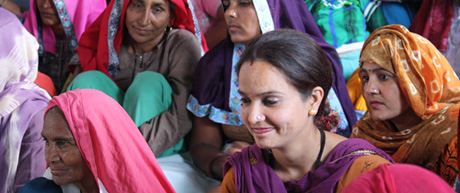Data on Women

Fact and Figures on Women in South Asia
South Asia’s rankings for many gender gap indicators— health, adult literacy, economic participation—are often close to or lower than those in sub-Saharan Africa.
Source: Power, Voice and Rights – A Turning Point for Gender Equality in Asia and the Pacific, UNDP
Leadership & Participation
- On average, women hold only 7 percent of ministerial positions and 15 percent in national parliaments in all the 9 countries of South Asia region.
Source: Progress of World’s Women: Access to Justice, 2011-12, UN Women - In India, women have a share of 10 percent and 11 percent respectively in ministerial positions and the national parliament.
Source: Progress of World’s Women: Access to Justice, 2011-12, UN Women - Less than half of South Asian countries have a Constitutional quota for women in their national parliaments.
Source: Progress of World’s Women: Access to Justice, 2011-12, UN Women - In South Asia only 7 percent women are members of political parties
Source: World Development Report 2011 - Low representation of women leaders across South Asia: Bangladesh (18.5 percent in the 2008 Parliament); Bhutan (8.5 percent women in the National Assembly); Sri Lanka (5.8 percent in the Parliament)
Source: UN Women & ICRW 2011 - In Bhutan only 21 percent women are opposed to quotas (UN Women 2011)
- Nepal’s 2007 Interim Constitution ruled that women must be at least 33 percent of candidates, paving the way for an increased role for women in politics.
Source: Progress of World’s Women: Access to Justice, 2011-12, UN Women - Across South Asia, women make up less than 5 percent of the police and less than 10 percent of judges.
Source: Progress of World’s Women: Access to Justice, 2011-12, UN Women
Economic Empowerment
- 74.8 percent of rural women in India are agricultural workers but only 9.3 percent own the land.
Source: The 2002 Indian National Sample Survey, Agriculture Census 2005/ 2006, Department of Agriculture and Cooperation, Government of India - At 22 percent, Pakistan has the least women labour force participation.
Source: Progress of World’s Women: Access to Justice, 2011-12, UN Women - More than 80 percent of women in the region are employed in vulnerable jobs, which lack the protection of labour laws.
Source: Progress of World’s Women: Access to Justice, 2011-12, UN Women - Limits on women’s participation in the workforce across the Asia-Pacific region cost the regional economy an estimated US$89 billion every year.
Source: Progress of World’s Women: Access to Justice, 2011-12, UN Women - Women account for nearly two thirds of Sri Lanka’s one million international migrants, many of whom are employed in the Gulf States as domestic workers.
Source: Progress of World’s Women: Access to Justice, 2011-12, UN Women - Only 4 out of 9 South Asian Countries have equal inheritance laws between men and women for land and property. In Nepal, a tax exemption has been introduced to incentivise families to share property with their wives, daughters and sisters. As a result, between 2001 and 2009, women’s land ownership has increased threefold.
Source: Progress of World’s Women: Access to Justice, 2011-12, UN Women
Violence Against Women
- Based on prevalence surveys in some countries of Asia, nearly half of women have experienced physical and sexual violence at the hands of an intimate partner.
- According to the National Crime Records Bureau (NCRB) of India: 89,546 cases of cruelty by husband and relatives; 21,397 cases of rape; 11,009 cases of sexual harassment and 5,650 cases of dowry harassment were reported in India during the year 2009.
Source: National Crime Records Bureau (NCRB) India, 2009. - According to a survey in two countries in South Asia, 39 percent of men and women in India think that it is sometimes or always justifiable for a man to beat his wife.
Source: Progress of World’s Women: Access to Justice, 2011-12, UN Women - Out of 9 countries in South Asia, 5 countries (Sri Lanka, Bhutan, India, Pakistan and Bangladesh) have in existence legislation against sexual harassment. Only 4 countries (Sri Lanka, India, Nepal and Bangladesh) have laws to prohibit Domestic Violence. Global data shows that where laws are in place against domestic violence, its prevalence is lower and fewer people think it is acceptable.
Source: Progress of World’s Women: Access to Justice, 2011-12, UN Women
Women, Peace and Security
- Fewer than 3 percent of signatories to peace agreements are women.
Source: UN Women’s Research on Women’s Participation in Peace Processes 2010